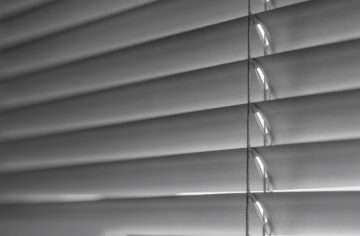As a new parent, few things matter more than your baby’s sleep, both for their wellbeing and development, and for your own peace of mind. You may have tried all the tricks in the book: swaddling, rocking and white noise machines but one of the most overlooked tools in supporting healthy sleep for babies is something deceptively simple – darkness. Have you tried blackout blinds for your baby’s nursery?
Did you know that babies are far more sensitive to light than adults and even the smallest amount of light can disrupt your little one’s sleep? If you’re keen to improve your baby’s sleep habits, you’re in the right place. Here, we’ll explore the science behind light and sleep and show how installing a good quality nursery blackout blind could be the answer to your problems.
The Science Behind Light and Sleep
We all have a built in circadian rhythm, better known as our ‘ internal body clock’ and this is what makes us feel alert during the day and sleepy at night. However, babies aren’t born with fully developed circadian rhythms. In fact, it takes several weeks, sometimes months, for their internal clock to start syncing up with the 24-hour day. During this time, exposure to light and darkness plays a key role in shaping healthy sleep patterns.
Think about the womb; it’s a consistently dark, snug environment. For newborns especially, darkness feels familiar and safe. When your baby is placed in a dark room, it encourages melatonin production, better known as the ‘sleep hormone’ which is produced naturally by our bodies in response to darkness. The womb was also a place free from external distraction; there were no shifting shadows or bright car headlights keeping little minds alert. This was the perfect environment to sleep in, so mimicking this by installing the best blackout blind in your baby’s nursery seems like common sense.
Benefits of Blackout Blinds for your Baby’s Nursery
Consistency and predictability are key to infant sleep patterns; babies need to learn that a dark environment is associated with sleep. However, this can be especially problematic in the spring and summer months when the sun sets later in the evening. Excessive light pouring in through standard blinds or curtains can confuse your baby and act as a distraction, keeping them awake for longer.
This is where blackout blinds come in. By installing a good quality, thick blackout blind, you can eliminate all light from your baby’s nursery. This is crucial in establishing a healthy sleep routine. Whether it be during daytime naps or at bedtime, blacking out your child’s nursery gives his brain the cue he needs: that it’s time to sleep. Sleep Consultant, Lucy Sterry (Founder of Nurture Nest Company) explains that “Blocking out light helps to promote the production of melatonin which allows us to wind down, reduce core temperature and transition into a deep, restorative sleep.”
When lying in a calm, dark room, babies are more likely to experience longer stretches of good-quality sleep. Their wake time will also be later in the morning; many babies naturally stir around dawn, and if unwelcome light is streaming into the room, they’re more likely to fully wake up. Keeping the room dark in the early morning helps your baby sleep longer. And let’s face it, a good night’s sleep has the power to completely transform how you and your little one feel during the day.
Choosing and Using Blackout Blinds for Your Baby’s Nursery
When it comes to optimising your baby’s sleep environment, investing in high-quality blackout blinds for your baby’s nursery is essential.
What Should You Look For When Choosing a Blackout Blind?
Total light blocking: True blackout blinds block 100% of external light. Blackout blinds for children’s rooms should ensure that no light seeps in.
- Safety features: For nurseries and young children’s rooms, cordless blinds or those with secure cord systems are the safest choice to avoid any entanglement risks.
- Ease of use: Look for blinds that are easy to raise and lower and do so quietly to minimise disturbance.
- Custom fit: Gaps at the edges can let in light. A snug fit inside the window frame can help block every beam.
How Can Parents Install Blackout Blinds Effectively to Ensure Maximum Darkness?
Getting the installation right is key to making sure blackout blinds actually do what they promise: keep the room truly dark. Follow these 5 simple steps for easy installation:
Step 1) Before buying blackout blinds for your baby’s nursery, take precise measurements of your window’s height and width, and double-check these before making any purchase. Too small, and you’ll end up with gaps; too large, and installation might get tricky.
Step 2) Using a pencil, mark where the brackets will be installed. Be sure to use a spirit-level to ensure your markers are equal.
Step 3) Drill holes where you’ve marked, then screw the brackets securely into place.
Step 4) Carefully place the blinds into the installed brackets according to the instructions.
Step 5) Gently pull down on the blinds to ensure they are secure and operate smoothly.
Blackout blinds for your baby’s nursery are a simple yet powerful addition to your nursery setup, helping to block out disruptive light and support healthy sleep patterns right from the start. Whether it’s for daytime naps or early bedtimes, these blinds can make a real difference in how well your little one settles and stays asleep. And let’s be honest, when your baby sleeps better, everyone sleeps better.
To find out how we can assist you in creating the ideal sleep environment for your baby, click here or visit one of our stores and one of our experts will be on hand to help.

